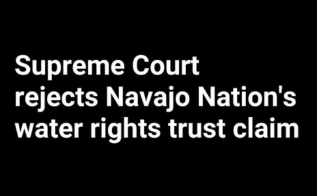Indigenous Property Perspectives … and how they differ from Western Law

By: Peter d’Errico
A world of “ours” and a world of “mine”
I say amazing because readability is a quality not usually found in law reviews, especially in the arcane field of property law, which Riley correctly observes is a “patchwork of legal rules and property puzzles …[alongside] incomprehensible and mind-bending irregularities”.
Riley is a member of the Citizen Potawatomi Nation and, in addition to being a law professor and director of the Native Nations Law and Policy Center, is Chief Justice of the Citizen Potawatomi Nation Supreme Court. From this multifaceted perspective, she carefully explains the differences between Indigenous property perspectives — a world of “all our relations” — and Anglo-American individualistic perspectives. Two worlds emerge in her essay: a world of “ours” and a world of “mine”.
Her choice of title, “Before Mine!: Indigenous Property Rights for Jagenagenon” is itself analytical and historical. It summarizes the differences between the two worlds by juxtaposing “Jagenagenon” (Potawatomi “for all my relations”) with Mine! and reminds us that Indigenous property perspectives predate the importation / imposition of Anglo rules in Turtle Island.
Riley states her purpose this way:
My primary objective in this Review is to use Mine! as a jumping-off point to introduce and then contrast its central tenets with an Indigenous property perspective. In doing so, I seek both to show how the property rules articulated in Mine! have historically been used and misused to justify the mass dispossession of Indigenous lands in the United States and, further, to demonstrate how the underpinning of those property theories stands in sharp relief to property systems found in many Indigenous communities.
Riley opens with a brief discussion of “six foundational property axioms… deeply rooted in Anglo-American property theory… [and] predominantly driven by individual interests”:
-
…first come, first served…
-
…possession is nine-tenths of the law…
-
…you reap what you sow…
-
…my home is my castle…
-
…our bodies, ourselves…
-
…the meek shall inherit the earth…
She notes that even though entities like corporations involve multiple owners, their structures “are developed, maintained, and defined by laws and legal rules that …focus on individual rights.”
The ‘corporate person’ as ‘individual right’ in US law
Justice Stephen J. Field wrote the majority opinion; he said:
“… corporations are creatures of the state; they could not exist independently of the law…. But the members do not, because of such association, lose their rights to protection, and equality of protection. They continue, notwithstanding, to possess the same right to life and liberty as before, and also to their property….”
Field rationalized the ruling with a series of hypothetical statements conflating discrimination based on individual human characteristics with discrimination based on economic categories.
He said:
“It would be a singular comment upon the weakness and character of our republican institutions if the valuation and consequent taxation of property could vary according as the owner is white, or black, or yellow, or old, or young, or male, or female… Strangely, indeed, would the law sound in case it read that in the assessment and taxation of property a deduction should be made for mortgages thereon if the property be owned by white men or by old men, and not deducted if owned by black men or by young men; deducted if owned by landsmen, not deducted if owned by sailors; deducted if owned by married men, not deducted if owned by bachelors; deducted if owned by men doing business alone, not deducted if owned by men doing business in partnerships or other associations; deducted if owned by trading corporations, not deducted if owned by churches or universities; and so on, making a discrimination whenever there was any difference in the character or pursuit or condition of the owner. To levy taxes upon a valuation of property thus made is of the very essence of tyranny, and has never been done except by bad governments in evil times, exercising arbitrary and despotic power.”
Field waxed panegyrical, celebrating the 14th Amendment’s guarantees of “due process” and “equal protection of law” as a means to expand the rights and powers of corporations:
“[The 14th Amendment] attends every one everywhere, whatever be his position in society or his association with others, either for profit, improvement, or pleasure. It does not leave him because of any social or official position which he may hold, nor because he may belong to a political body, or to a religious society, or be a member of a commercial, manufacturing, or transportation company. It is the shield which the arm of our blessed government holds at all times over every one, man, woman, and child, in all its broad domain, wherever they may go and in whatever relations they may be placed.”
When the Santa Clara case got to the US Supreme Court, it simply rubber-stamped the ruling. The court reporter quoted Chief Justice Morrison Waite telling the lawyers there would be no point in arguing about it:
“The court does not wish to hear argument on the question whether the provision in the Fourteenth Amendment to the Constitution, which forbids a State to deny to any person within its jurisdiction the equal protection of the laws, applies to … corporations. We are all of opinion that it does.”
In short, as Riley says, US corporate property rules were “developed, maintained, and defined by laws and legal rules that …focus on individual rights.” The high water mark of “corporate person” rights continues to rise, as in Burwell v. Hobby Lobby Stores, Inc. (2014), where the Supreme Court said:
“The plain terms of [the Religious Freedom Restoration Act] make it perfectly clear that Congress did not discriminate …against men and women who wish to run their businesses as for-profit corporations….”
An Indigenous Earth Riley moves into the heart of her essay by emphasizing the historical precedence of Indigenous property perspectives:
“This Review does not pick up where Mine! leaves off; rather, it serves as a prequel of a sort, offering insights based on Indigenous property formations that far predate the concepts discussed in Mine!”
She contrasts Indigenous property with Anglo-American law in three points:
“Indigenous cultures are as exceptionally collectivist as American culture is individualistic.”
In Indigenous property systems, “the earth is imbued with sacred elements that are entirely nonfungible, a fact that stands in stark contrast to the ‘everything has a price’ view [of Anglo concepts].”
“Indigenous …systems are rooted in the divine interconnectedness of all things in the universe, …referred to in Potawatomi as ‘Jagenagenon’ (‘for all my relations’)….”
She says:
“Tribes’ spiritual beliefs do not afford two-leggeds (humans) dominion over animals and all other living things on the planet (including the planet itself), as contrasted with Western religion and philosophy. To the contrary, Indigenous cosmologies place humans in relation to all other living things, viewing everything in the universe as intricately connected.
In Federal Anti-Indian Law: The Legal Entrapment of Indigenous Peoples, I refer to this perspective as an “Indigeneous nomos of the Earth”.
The ‘civilized’ attack on Indigenous peoples
Riley next provides an overview of how Indigenous property practices were (and are) a prime target of US law. In the 1950s, sharing of Tribal resources was equated to ‘communism’; from the earliest colonial times Tribal communal relations to land were cited as evidence of a lack of ‘civilization’ — which the colonizers presumed required individual acquisition and ‘advancement’.‘Allotment’, ‘relocation’, and ‘termination’ schemes were imposed to destroy Tribal land bases and coerce Tribal peoples into the ‘competitive individualism’ of American society, which US law viewed as the apotheosis of ‘civilization’.
Riley says Mine! delves into the 1823 Supreme Court case, Johnson v. McIntosh, that legalized the dispossession of Indigenous peoples on the basis of a property concept that categorized Indigenous peoples as “occupants” rather than owners of their lands and said that the US holds “title” to Indigenous lands as the “Christian discoverer”.
Justice Joseph Story, a member of the Marshall court, starkly summarized the concept in these words:
“The title of the Indians was not treated as a right of propriety and dominion; but as a mere right of occupancy. As infidels, heathen, and savages, . . . [they] were not allowed to possess the prerogatives belonging to absolute, sovereign and independent nations”
(Commentaries on the Constitution of the United States, 1833)






Responses